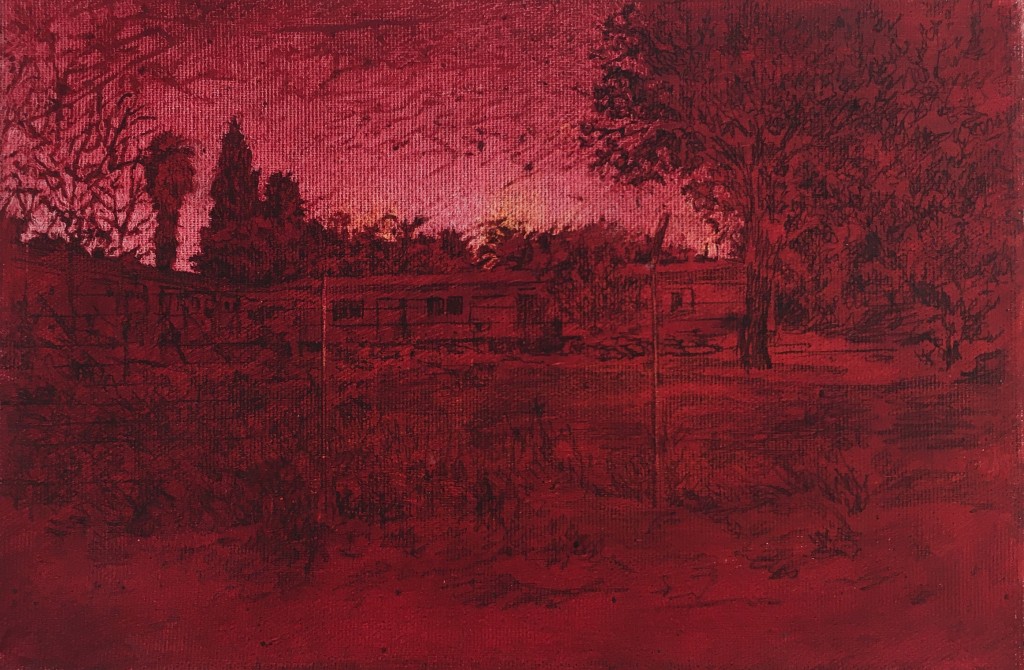הציורים האדומים של הדר גד חשופים. המעטה, השכבה המגינה על הבשר והנפש איננה, ולנו, לצופים, נותר להתבונן מרותקים ברגעים לוהבים, בזיקוק מדויק של תחושה ובאופן מסוים גם צליל. הציורים של גד כמו פועמים, פעימות לב שמנסה לרדוף אחר השד יודע מה.

גד מרחיבה את מושג ציור נוף, טורפת את ההנחות לגבי החלוקה לסוגות. לציור בחוץ, מהתבוננות, מסורת ה En plein air הצרפתית היא מביאה בדי קנווס שכבר נצבעו, על ידה, באדום, לעיתים באדום וצהוב. צביעה, המריחה של הצבע ביד חשופה היא כמו טקס. הטקס אמנם פרטי אך מהדהדות בו מסורות: מריחת הדם הזכורה ביותר ביהדות היתה בסיפור הפסח כשבני ישראל מרחו דם על משקופי בתיהם כדי שהאל יבחין ולא ימית את בכורם, כמו את בכורי המצרים במכת בכורות, כלומר הדם הוא הדרך להוושע ושלב בגאולה לחרות.
אדום דם, והאדום של גד הוא כזה, מתקשר לדמו של ישוע, לדמם של קדושים, לבריתות דמים, כלומר לקורבן ולישועה. יש באדומים של גד, גם נגיעה בתהומות בהם אדום הוא דם מטמא, כמו דם נידה. ברווח בין המקודש למנודה הציורים יוצרים חלל חדש, מרהיב עד כאב.
את המצעים האדומים גד לוקחת איתה לנופים לא תמימים. העבודות ב”אדומים” צוירו מנופים בקיבוץ עין חרוד והמרכז לבריאות הנפש “שער מנשה” הנמצא באזור פסטורלי, לא רחוק מקיבוץ עין שמר, (סמוך למקום מגוריה של גד), בעוד גד מכירה את עין חרוד היכרות קרובה, אינטנסיבית, כבת למשפחה מהמקום, וכאמנית המציירת בו כבר שנים (תערוכת יחיד גדולה נערכה לגד במשכן לאמנות ב-2009) , הרי ב”שער מנשה”, מרכז לבריאות הנפש, לא ביקרה גד מעולם. התבוננותה במקום נעשתה מבחוץ, מעבר לגדרות המקיפים את מה שנראה כישוב קטן ופסטורלי.
קיבוץ עין חרוד מצוי בלב ליבו של הקונזנזוס הישראלי, “שער מנשה” הוא הדחוי, המודחק. היהודי החדש, זה שהקיבוץ ביקש לעצב, והתקבל כמודל הצבר האידאלי, היה אמור להיות בריא בנפשו, נעדר קומפלקסים. “שער מנשה” מנכיח את המרחק בין אידאל למציאות. למרות זאת הנוף בשני המקומות דומה עד שכמעט לא ניתן להבחין אם המקום בציור הוא הקיבוץ או “שער מנשה”. אפשר לחשוב על המרחק הזה גם כהשלמה, הכרה במורכבויות אנושיות.
על הקנווסים האדומים, שבולטים למרחוק בנוף הירוק- מאובק, גד רושמת בעיפרון. מסמנת מבנים, גדרות, קבוצות עצים, המרכיבים ההופכים עם העברתם לציור ל”נוף”. על המצע מתקבל מתאר תחרה שברירית, זיכרון יותר מאשר נוכחות.
בסטודיו גד משתמשת בסכין חיתוך (סכין יפנית) לעשייה שבהעדר מילה אחרת נכנה “ציור”. ההתגרות המתמידה בסכנה שיש בעבודה עם הסכין מתקשרת לבחירת הצבע. אדום משמש באופן אוניברסלי לשלטי אזהרה, לסימון איום. גד מגרדת את שכבות הצבע כמי שמגרדת גלדים מצלקת, אבל מחפשת בהם אור.

האור, שהחיפוש אחר הדרך לתארו הוא כמעט סיפור היסטוריית הציור כולה, הוא נושא מרכזי גם בסידרה זו. אור הוא מטאפורה ל”טוב” בין אם זה נתפס באופן רליגיוזי או פוליטי. אדום מתקשר לאוטופיה הקומוניסטית, (“אדומים” הוא כינוי מקובל לקומניסטים ולסוציאליסטים), וזו השתמשה, כמו הדתות הגדולות לפניה, בדימוי של אור וזריחה להבטחת אידיליה. גד חושפת אור בסכין החיתוך, מבהירה חלקים בציור, עוקבת-לא עוקבת אחר הרישום, והיא כמפסלת פני שטח מחוספסים, חומריים שיוצרים תחושה של בערה פנימית. העבודות יוקדות, לא שקטות, משתנות.
האיכות הלוהבת, הטמפרטורה הגבוהה של הצבע פועלת כישות כמעט נפרדת מהדימויים. אלו, אוצרי סוד, נדמים כפסטורליים, אך הופכים טורדים: לפני בתים עם גגות רעפים עומדת גדר קוצנית, בינות עצים מתגלים כפרים. ככל שמאריכים בהתבוננות האיכות הרומנטית המסוימת שיש לציורים מתמוססת והדחיפות והעוצמה, הכאב והבוהק של התבוננות במה שמתחת לפני השטח, כמו געש שרק בקושי נותר מרוסן, מתפרץ לפני הצופים ביופי נורא.
(טקסט התערוכה )
אוצרת : דר’ סמדר שפי
גלריה רוטשילד , רחוב יהודה הלוי 48 תל-אביב . הפתיחה ביום חמישי, 7 בספטמבר 2017 בשעה 20:00.
לניוזלטר הפירסומי השבועי של “החלון” בנושאי אמנות, אירועים ותערוכות חדשות
www.smadarsheffi.com/?p=925 (הרישום נפרד מהרישום לבלוג )
החלה ההרשמה לקבוצת סיורי האמנות הקבועה 2017-18 לפרטים כיתבו ל
thewindowartsite@gmail.comScars of lace: RED – an exhibition by Hadar Gad
Hadar Gad’s red paintings are unprotected. They lack the layer covering flesh and soul, leaving viewers mesmerized as they observe the conflagration with a precise sensation of flames and perhaps fleeting illusion of sound. Gad’s paintings beat like a heart in pursuit of who knows what…
Gad expands the concept of landscape painting, reshuffles categorization into genres, and reinterprets the French tradition of painting outside en plein air. Gad brings primed canvases to her painting sessions outside, the surfaces already covered with red oil paint, sometimes adding yellow to the red. The smearing of the oil paint with her bare hands, part of her practice, has the quality of a ritual. Although a personal act, it resonates tradition and ritual. The smearing of the paint brings to mind the blood of the Paschal lamb painted on the doorposts of the Israelites’ homes in Egypt so that the Lord would pass over their firstborn sons as He smote the Egyptians’ firstborn. In this case, the red blood is the tool of deliverance, one step towards freedom.
Blood red initiates references to the blood of Jesus, martyrs, and blood covenants, a sign of sacrifice and redemption. Gad’s reds also refer to the abyss in which red signifies pollution, as in menstrual blood. In this space between the sanctified and the impure, Hadar Gad’s paintings create a new space which is breathtaking to the point of pain.

Gad’s depictions of landscapes are far from innocent. The paintings on view in Red re of views of Kibbutz Ein Harod and Sha’ar Menashe mental health center located in a pastoral area, not far from Kibbutz Ein Shemer (and from Gad’s home). Although the artist has a close and intensive relationship with Ein Harod, having been born there to a family of founders and members, and as an artist who has been painting there for years (with a large one-person exhibition at the Ein Harod Museum of Art in 2009), she has never visited the Sha’ar Menashe hospital. She observes from the outside, behind the fence surrounding what looks like a small rural settlement.
Kibbutz Ein Harod lies in the very heart of the Israeli consensus, while Sha’ar Menashe is the rejected and repressed. The “New Jew” which the kibbutz sought to shape, the model of the ideal sabra, was supposed to be mentally healthy without psychological complexes. Sha’ar Menashe makes present the distance between the ideal and the real. Yet despite this, the views from both locations are so similar that it is nearly impossible to detect whether the painting is of the kibbutz or the mental health center.
On the red canvases which stand out from afar in the dusty greenish landscape, Gad sketches in pencil. She marks out structures, fences, groups of trees – the components that create the transformation into “landscape painting.” The outcome is a surface of fragile lacy patterns of memory more than of presence.
In the studio, Gad uses a box cutter to create her works, playing with the concept of danger associated with her choice of the color red, a universal sign of warning, signaling threat. She scrapes into the layers of paint as if removing coagulated blood from a scar, while seeking the light within.
The search for light may be said to encapsulate the entire history of painting, the major theme in this series, as well. Light is metaphorical “good,” whether religious or political, while red is associated with the Communist utopia (with “Reds” referring to Communists and Socialists). Communism, like others before it, used the image of light and sunrise to symbolize the promise of an ideal life. Gad reveals light by using her mat knife to lighten portions of her painting, following or diverging from her drawing. She sculpts into the rough material surface creating a feeling of internal combustion.

The quality of the flame and high temperature of the color operate like an entity independent of the images. The latter contain a secret, seemingly pastoral, yet transformative and disturbing: a thorny fence stands in front of shingled houses, among the trees villages gradually reveal themselves.
The longer we observe Gad’s paintings, the somewhat Romantic quality in the paintings fade, and the urgency, power, pain and splendor of what is below the surface erupts in its terrible beauty.
Curator Dr. Smadar Sheffi
The Rothschild Fine Art Gallery, Tel Aviv
Join the mailing list for Window’s weekly informational advertising newsletter –
www.smadarsheffi.com/?p=925
For information about Art tours – please write to thewindowartsite@gmail.com






